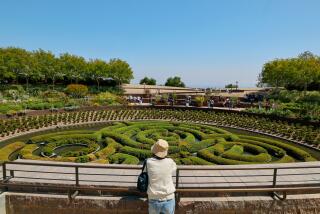WHAT’S BEHIND THAT $40-MILLION BOUQUET?
- Share via
TOKYO — To the Yasuda Fire & Marine Insurance Co., the auction of Vincent van Gogh’s painting “Sunflowers” at Christie’s in London was “a never-again” opportunity. That’s why the company paid a record $39.85 million for it, a spokesman said here Thursday.
Yasuda, Japan’s second largest non-life insurance company, was not identified as the buyer March 30. But the company gave Christie’s permission Wednesday to reveal its name in London after worldwide clamor developed over the mystery. It also issued a news release on the purchase here Thursday.
The price that Yasuda paid, more than three times the highest previously paid for a painting at auction, does not herald the beginning of a new price spiral or competition in the world art markets by either Japanese in general, or Yasuda in particular, said Yoshiro Kori, a section chief in the company’s public-information department.
Rather, he said, it was a one-time phenomenon.
In Japan, Van Gogh’s “Sunflowers” paintings are special, Kori said. The paintings of dazzling yellow sunflowers in a vase have a fame that no other Van Goghs--indeed, no other Impressionist painting--enjoy, he said.
“Every Japanese in the country, even schoolchildren, knows the painting,” he said. Students in both elementary and junior high school study it in their art classes as one of the world’s great art works. Photographs of the painting are included in textbooks, he added.
A test with two randomly selected college students proved him correct. Shown a photograph of the painting, both, without coaching, were able to identify it immediately by title and artist. Both said they first saw it in school.
Realizing the meaning of “Sunflowers” to the Japanese public at large, Yasuda determined to buy it when it heard that the painting would be on the market, Kori said.
The company, which for more than 60 years has acted as promoter of art exhibitions and sponsor of young artists in Japan, opened an art museum of its own to commemorate the completion of its new 43-story headquarters building in the Shinjuku section of Tokyo in 1976. That will be the new home for “Sunflowers,” if all goes well.
The museum, named in memory of Seiji Togo, a famous oil painter whom Yasuda started sponsoring when he was only 20, is located on the 42nd floor of the building. Already, it houses more than 450 works of art, mostly by Japanese and French 19th-and 20th-Century artists--but also a work by America’s Grandma Moses. Among its world-famous works are paintings by Renoir and Picasso.
With the firm’s 100th anniversary coming up in October, 1988, Yasuda was already looking for “a suitable masterpiece . . . to crown the festivities” when Christie’s announced the auction of the Van Gogh work.
Yasuda knew that only six of the seven original “Sunflowers” paintings done by Van Gogh in his Arles period from February, 1888, to May, 1889, still remained in existence, Kori said. The Dutch painter, unable to sell his works, committed suicide at the age of 37 in 1890.
The seventh “Sunflowers” was owned by businessman Koyata Yamamoto, who kept it on the wall of the tokonoma (place-of-honor alcove) in the living room of his traditional-style wooden house in Ashiya, near the port city of Kobe. The painting was destroyed during an American bombing attack in World War II.
Four of the “Sunflowers” are in museums in Philadelphia, London, Munich and Amsterdam--”which meant that none of them was ever likely to go on the market,” Kori said.
Another “Sunflowers” is still held by a private collector, but “it is the smallest of them all, measuring only 73 by 58 centimeters, and has only four sunflowers in it,” he added.
The painting sold at Christie’s on March 30 is one of the two biggest of the seven--measuring 100.5 by 76.6 centimeters--and is identical in size to the one displayed by the Philadelphia Museum of Art.
“We thought it was the last time an opportunity to bring ‘Sunflowers’ to Japan would ever occur,” Kori said. “If we had not bought it, the painting would not have come to Japan.”
Yasuda, he added, also wanted the painting because Van Gogh did the work at approximately the time that the company was founded, making it all the more appropriate for the firm’s 100th anniversary celebration.
The painting was done in January, 1889, three months after Yasuda Fire & Marine Insurance Co. was founded. Van Gogh told his brother, Theo, an art dealer, that he hoped to sell the work for 500 francs, then worth about $500.
There is still a small chance that the painting will not come to Japan. Under British law, there is a waiting period in which the British public is given time to raise an equivalent amount--$39.85 million in this case--to buy back art treasures and prevent them from leaving the country. The period, including the time needed to pay taxes and clear the painting through British customs, will be about six months, Kori estimated.
After the painting arrives in Japan, Yasuda plans to put it on exhibit in Tokyo first and then show it in exhibits in a yet undetermined number of other Japanese cities. Ultimately, it will be displayed at the company’s 42nd-floor headquarters museum, and special security measures will be taken, he said.
The museum is open to the public 9:30 a.m. to 4:30 p.m. Mondays through Fridays for a charge of 300 yen ($2.07) for adults and 150 yen ($1.03) for children. Kori said the firm recognized that acquisition of the painting threatened to create a demand to open the museum on Saturdays and Sundays as well. But, so far, the company has no plans to do so because of the costs of providing security for the entire 43 stories of the building on weekends, when the office portion of the building is closed.
Yasuda has no plans to lend the painting to overseas museums now, but does not rule out such a possibility in the future, he added.
The purchase of “Sunflowers” was not the first time that a Japanese buyer had paid a steep price for a famed work of art. Yasuda and other Japanese companies and even museums in smaller regional centers of Japan have been buying works of art overseas in recent years.
The city of Nagoya, for example, is reportedly planning to buy a foreign painting for $2.4 million to serve as the centerpiece of a new municipal museum scheduled to open next year.
Two of the most famous collections of foreign art in Japan were assembled by Japanese corporations--the Bridgestone Tire Co. and the former Ataka & Co., a trading firm that went bankrupt and was amalgamated into Sumitomo Trading Co.
Kori, however, said Yasuda has no intention of buying more art for sums as large as it forked over for the Van Gogh.
Before “Sunflowers,” the most that Yasuda ever paid for a painting was 250 million yen--$1.7 million at the current exchange rate. That was for a Renoir depicting a woman bathing, Kori said. It also paid 150 million yen--$1.03 million--for a Renoir painting of a girl in a hat. Both Renoir purchases were made last year.
Kori said the price that Yasuda paid for “Sunflowers” was 5.3 billion yen--$36.55 million-- before Christie’s commission was added. The last bidder in competition with Yasuda was reported to be an unidentified private collector from Switzerland, he added.
Tokyo customs statistics indicated that Japanese bought more than $207 million worth of foreign art works in 1985 alone. Through August last year, Japanese had bought 35 paintings worth $100 million yen ($690,000 at current rates) or more apiece, compared to 29 works of roughly equivalent value in all of 1985.
Imports from France accounted for 55% of the total in monetary value, followed by the United States, Switzerland and Britain.
Works by Impressionist painters such as Renoir, Cezanne, Monet, Laurencin, Chagall and Picasso have been high on Japanese shopping lists.
With a 65% appreciation in the value of the yen since September, 1985, Japanese, who had concentrated earlier on what one Tokyo art dealer called “middle-of-the-road Impressionists,” have moved up to the higher-quality works in their buying.
More to Read
The biggest entertainment stories
Get our big stories about Hollywood, film, television, music, arts, culture and more right in your inbox as soon as they publish.
You may occasionally receive promotional content from the Los Angeles Times.










